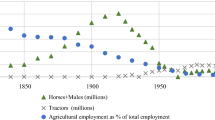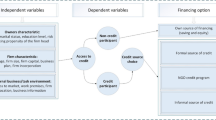Abstract
Microfinance projects now seek to achieve improvement in environmental quality in addition to poverty alleviation. Achievement of these goals may depend upon the economic and environmental impact of microfinance businesses. This study is a quantitative analysis of these outcomes for Ecodevelopment, an Indian microfinance project, which aims to prevent forest degradation by poverty alleviation. The study divides businesses into perishable goods, non-perishable goods, simple skills, and special skills and measures their economic outcome by two indicators, repayment percentage and continuity of businesses. The study examines the effect of loan amount on the economic outcome of businesses. To quantify the environmental outcome, it analyzes the use of firewood or fodder and release of pollutants by businesses. The results show that loan amount does not affect the economic outcome, special skills have best performance, and skills cause less pressure on forest resources. These results suggest the need for development of knowledge-intensive skills, involvement of institutions in the operations of business, and inclusive policies for protected area management.
Similar content being viewed by others
References
Anderson C.L., Locker L., Nugent R., 2002. Microcredit, social capital, and common pool resources World Development 30(1): 95–105
Chichilnisky G., 1998. Sustainable Development and North–South Trade in Guruswamy LD, Mc Neely J, (eds), Protection of Global Biodiversity Duke University Press Durham, NC 102–117
Chidambaram, P.: 1999, Phase-out some subsidies. The Hindu (February 13, 1999)
Coleman J.S., 1988. Social capital in the creation of human capital American Journal of Sociology 94(Supplement): S94–S120
Conlin M., 1999. Peer group micro-lending program in Canada and U. S Journal of Development Economics 60: 249–268
Gale Group: 2002, Microfinance – Expanded Academic ASAP. Accessed 4/19/02
Getz W.M., Fortman L., Cumming D., du Toit J., Hilty J., Martin R, Murphree M., Owen-Smith N., Starfield A.M., Westphal M.I., 1999. Sustaining natural and human capital: villagers and scientists Science 283: 1855–1856
Grameen: 2002, Breaking the vicious cycle of poverty through microcredit. www.grameen-info.org/bank/bcycle.htm. Accessed February 14, 2002
Jayaraman, K.S.: 1996, ‘“Indian Ginseng” brings royalties for tribe’, Nature 381(16 May)
Jha S., 2000. Preservation and conservation through participation in two Indian projects: a policy perspective AMBIO 8: 527–528
Jha S., 2005. Can natural world heritage sites promote development and social harmony? Biodiversity and Conservation 4: 979–989
Inamdar A., de Jode H., Lindsay K., Cobb S., 1999. Capitalizing on nature: protected area management Science 283: 1856–1857
McNamara R., 1973. Address to the Board of Governors World Bank Group Nairobi
Microcredit News: 2004, State of Microcredit Summit Report 2004. Available from http://www.microcreditsummit.org/enews/2004–12_index.html. Accessed May 27, 2005
Mosley P., 2001. Microfinance and poverty in Bolivia Journal of Development Studies 37(4):101
Myers N., Mittermeier R.A., Mittermeier C.G., da Fonseca G.A.B., Kent J., 2000. Biodiversity hotspots for conservation priorities Nature 403: 853–858
Sinclair A.R.E., Ludwig D., Clark C.W., 2000. Conservation in the real world Science, 229: 1875
Srinivas, S.: 1998, Microfinance: The Self-Employed Women’s Association. Whole Earth, Spring, 95
Stix G., 1997. Small (lending) is beautiful Scientific American 4: 18–20
United Nations: 2005, The Millennium Development Goals. Available from http://www.un.org/millenniumgoals. Accessed October 21, 2005
World Bank1998. Conserving Biodiversity through Ecodevelopment The World Bank South Asia Brief
Acknowledgements
R.K. Ojha,V. K. Melkani, S. Dutt, A. Sivasankaran, P Soranappan, Forest watchers of KMTR, and the NGO-workers helped with the field research. Wildlife Conservation Society, New York; Conservation, Food and Health Foundation, Boston; and National Geographic Society, Washington, D.C. provided financial support.
We are grateful to William Clark and three anonymous reviewers for suggestions.
Author information
Authors and Affiliations
Corresponding author
Rights and permissions
About this article
Cite this article
Jha, S., Bawa, K. The Economic and Environmental Outcomes of Microfinance Projects: An Indian Case Study. Environ Dev Sustain 9, 229–239 (2007). https://doi.org/10.1007/s10668-005-9020-5
Received:
Accepted:
Published:
Issue Date:
DOI: https://doi.org/10.1007/s10668-005-9020-5




